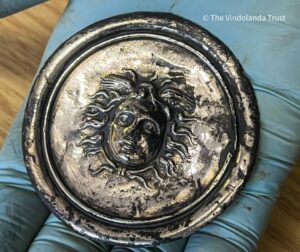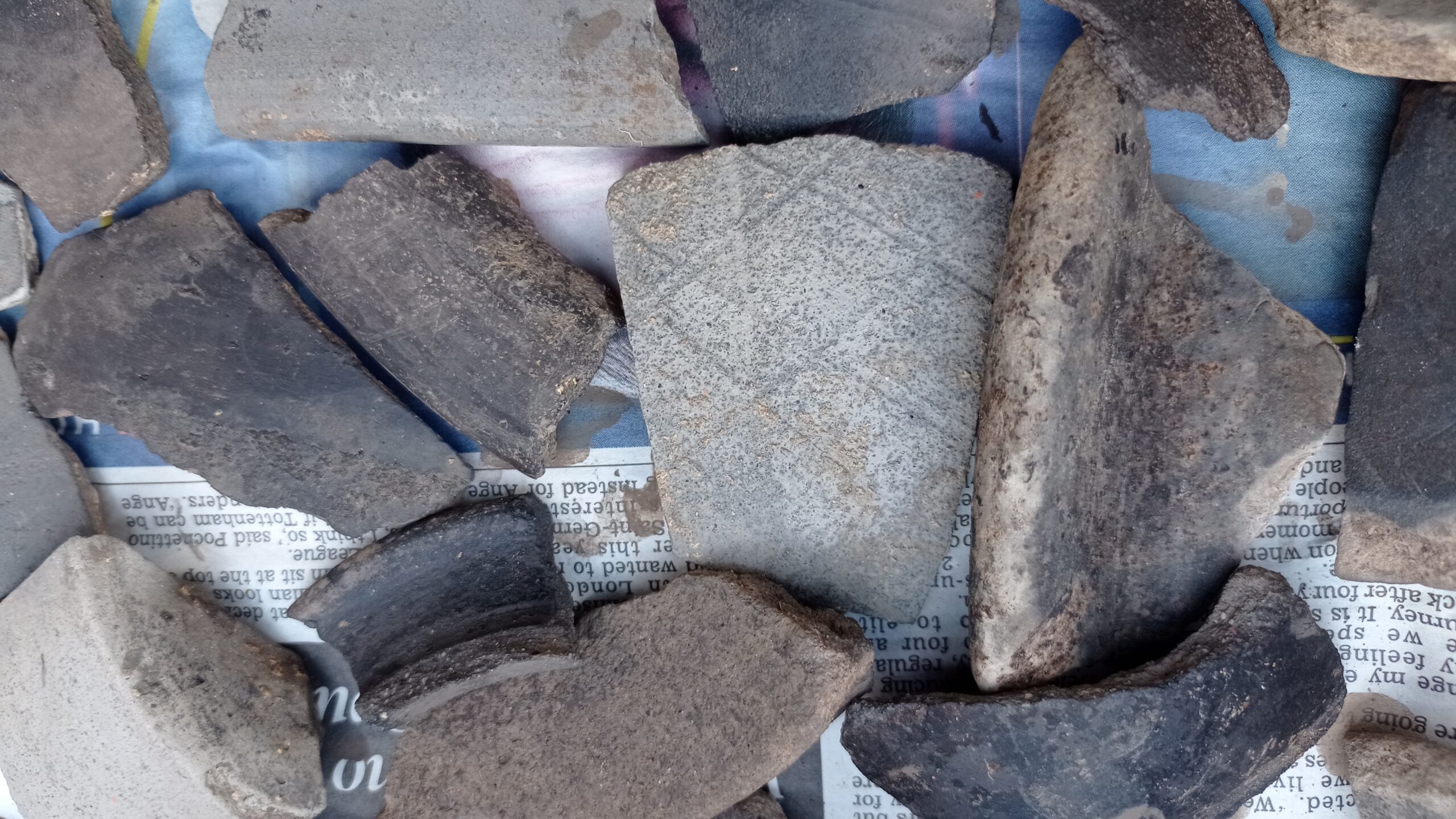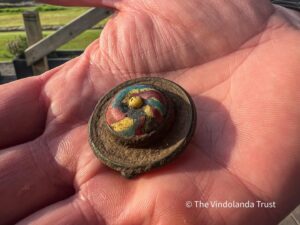
WHAT’S IT LIKE? Episode 9: Barbara Birley – Vindolanda Trust Museum Curator
 Name: Ms Barbara Birley
Name: Ms Barbara Birley
Areas of Specialism: Museum Curator
Topics of Interest: In no particular order – Vindolanda, Hadrian’s Wall, Frontiers of the Roman Empire, Museum Display, Evidence Interpretation, Visitor Engagement, Gaming on Heritage Sites, Material Culture (especially personal objects and organics), Finds Conservation and Climate Change in Archaeology.
Job Title: Curator – Vindolanda Trust
Job Responsibilities: This is always a fun question because a curator’s job is different depending on the organisation they work for. For me, as I work for an independent charitable museum, I am a person with many jobs. I often describe it as… ‘the person who looks after the Vindolanda and Magna artefacts after they have been pulled out of the ground’ ! This includes conservation, collection care and cataloguing, facilitation of research and publications, interpretation and display of artefacts for visitor engagement. I also look after our loans out programmes (where other museums ‘borrow’ items for their own exhibitions), the development of our contemporary arts programmes and I am working to develop our archives collections in the coming years so that we can open them for research too. I like that no two days are the same and I thrive on bringing together the different aspects of our collections and using them to their fullest potential.
Introduction
 I came to Vindolanda as a volunteer excavator from my native Denver, Colorado over 25 years ago and fell in love with the place. Not only is the Northumbrian countryside spectacular, but the site of Vindolanda itself is truly unique. At that time, the Trust only had a small volunteer excavator programme taking in a few students (of which I was one) and a few other interested individuals. Although I was studying history and archaeology, I soon realised that my core interest lay in the museum (I’d had too much exposure to sun, rain and shovelling as a field archaeologist).
I came to Vindolanda as a volunteer excavator from my native Denver, Colorado over 25 years ago and fell in love with the place. Not only is the Northumbrian countryside spectacular, but the site of Vindolanda itself is truly unique. At that time, the Trust only had a small volunteer excavator programme taking in a few students (of which I was one) and a few other interested individuals. Although I was studying history and archaeology, I soon realised that my core interest lay in the museum (I’d had too much exposure to sun, rain and shovelling as a field archaeologist).
In 1999, I was first employed by the Trust as a curatorial assistant and began to develop my curatorial skills, helping to take care of the museum and its collection. I went on to complete my MA from the University of Leicester and was promoted to Curator around 10 years ago. Unusually, the collection at Vindolanda is fortunate that it has only had two Curators over time, and the value of my experience working with Patricia Birley, (the Trust’s first Curator), cannot be underestimated.
In 2016, the Vindolanda Collection was Designated as having outstanding quality, national (and I would say international) importance and as being actively researched. This was a big achievement for me and the Trust, and I feel that it has given the collection its rightful place within the museums in the UK.
What is your daily life really like?

One of the things I love about my job is the variety. For example, some days are full of emails (which can be tedious), while other days have me working with international teams of researchers looking into specific and delicate aspects of our site and collection. This week alone, I have worked with our Roman shoe and leather specialist – Professor Elizabeth Green from the University of Western Ontario. Leather (and organic) finds rarely survive normally, but Vindolanda’s anaerobic soil conditions allow us to find all sorts of interesting things. Prof. Greene is cataloguing the leather objects in our collection, of which we have over 7000! She was excited to discover a new type of knockoff-shoe in the collection!
I have also worked in our conservation labs this week, finishing the objects from the 2024 excavation season at Vindolanda and Magna. While doing this, I am thinking about what I want to put on display in our recent finds case which we update each year (off goes the Medusa phalera and in comes a beautiful brooch). This morning, I had a Zoom meeting with colleagues in the Netherlands about linking a project working with community groups with physical and mental health challenges and Roman pottery. And then talked to researchers from the University of Readings REMADE project. In-between this there are lunchtimes with colleagues across the Trust where we have conversations on how we can collaborate with each other, develop Vindolanda and the Roman Army Museum, and make it fun to come to work each day.
What is the best part of your job?
Online exhibitions, developing digital apps and games, working with archaeological scientists and contemporary artists, researching and presenting at international conferences….. It’s hard to pick the best part of my job. I love the Trust’s innovative approach and its flexibility to deliver this range. The collection I hold in my care reveals new secrets constantly, but I think my favourite part of the job has to be the people. The Vindolanda team and the visitors who come to see us help to challenge me but also inspire me to continue my work.
Why do you think your specialism is important?
 Curatorship has changed significantly during my professional career; Many museums no longer employ subject specialist curators. In the past, there tended to be people who sat in storage rooms, cataloguing and researching the collections. This is still an important part of the job, but curators tend to look after entire collections and now actively engage with and deliver to the communities they serve.
Curatorship has changed significantly during my professional career; Many museums no longer employ subject specialist curators. In the past, there tended to be people who sat in storage rooms, cataloguing and researching the collections. This is still an important part of the job, but curators tend to look after entire collections and now actively engage with and deliver to the communities they serve.
Museums can be the platform for social and political change as we have seen in recent years with campaigns such as Black Lives Matter or climate change. Museums have a voice and, as they are respected in the community, they are expected to rise to the occasion, work with their learning and engagement colleagues to develop integrated, authentic and relevant engagement opportunities. Museums are the conduit of history, art and science through which the public interacts with the world around them. Without the people who understand the collections in their care, museums cannot uphold these values.

When looking at the collections I am responsible for, it is important to help visitors discover all aspects of our Roman past. This includes the unattractive parts from Roman imperialism and colonialism to slavery. For example, there has been an impressive amount of work to look at the Roman Army as a community and not just a male preserve. Our current research into our shoe assemblage (some 5000 objects) helps us to see that there were many women and children at the site as well as men. This might not sound too shocking now, but changes in research have happened slowly when based on the evidence of a collection.
If you didn’t have the job you do, what else could you apply your skills to?
If I did not have the job I have now I think I would work in another museum, look at other conservation work or maybe a book shop (did I mention I also am the book buyer for the museum shops?). I would still like to do something with history (preferably Roman or Medieval) and I love research, and presenting it to the public. I think that communication skills to different audiences are really important.
Did you always want to be what you are today?
 Growing up where I did, I did not have much access to many historic museum collections, but Colorado is known for geological and palaeontology collections. As a child, I spent many an hour at the Natural History Museum in Denver staring at dinosaurs and taxidermy animals. I was lucky enough when I was 11 years old to travel to Washington DC to visit the Smithsonian Museum and realised that many of the things I was reading about in books were real. This helped me to start asking questions about history, and once that started… it just has not stopped! I wanted to share my passion for history with others and although I considered teaching for a while, it was the museums that helped to combine my love of the ancient world with a practical vocation.
Growing up where I did, I did not have much access to many historic museum collections, but Colorado is known for geological and palaeontology collections. As a child, I spent many an hour at the Natural History Museum in Denver staring at dinosaurs and taxidermy animals. I was lucky enough when I was 11 years old to travel to Washington DC to visit the Smithsonian Museum and realised that many of the things I was reading about in books were real. This helped me to start asking questions about history, and once that started… it just has not stopped! I wanted to share my passion for history with others and although I considered teaching for a while, it was the museums that helped to combine my love of the ancient world with a practical vocation.
Where do you hope to be in 5 years time?
Yes, probably [I will keep doing this]. I love what I do and Vindolanda is a very special place to work. There are always more areas to research, more objects to look at and new projects to work on. Currently, I am really interested in the Roman textiles from Vindolanda. Some work has been done on them back in the 1970s-1990s but there are still so many questions needing answers.
What 3 tips would you give to someone who wants to follow a similar path?
- Stay curious
- It takes a team. I can’t do everything myself and we need others to support the work we do.
- Enjoy what you’re doing. If you don’t enjoy it, what’s the point?
A Final Note
If you want to know more about Vindolanda or Magna/the Roman Army Museum are active archaeological sites, and you can keep up to date on our work via social media and websites. This includes the excavations, a new contemporary art programme and work within our archives. I have recently published 50 objects from Vindolanda and this is a great introduction to the collections that I look after.


